Our History
The Early Years: Building a Church
1960s – 1980s: UUCPA and Social Unrest
The 21st Century: Building a Church Continued
A Commitment to Two Full-Time Ministries
Community Warmth and Spiritual Deepening
Social Justice: Within and Beyond
UUCPA Timeline, 1947-2022 with vintage photos
UUCPA Ministers and Religious Educators with photos of the ministers
The Early Years: Building a Church

Although a Unitarian church did exist in Palo Alto from 1906-1929, the present congregation began on April 13, 1947, when a charter membership roll was signed by 27 people. Initially, the small congregation was served by the minister of the San Jose Unitarian Church, whose support contributed significantly to the success of the Palo Alto group.
The congregation’s first settled minister, Rev. Felix Danford (Dan) Lion, was called in June 1949. Lion looked upon his role of establishing a liberal church in a college community as a challenge and an opportunity. In his words, “Those early 50s were days of political regression and repression, with Senator Joseph McCarthy bamboozling the American people…we as a church managed to raise aloft the standard of freedom to which many could repair.” Principles went into practice in 1952 when the Board of Directors refused to sign the loyalty oath required for a tax exemption.
The congregation first met in the Women’s Club building and then in the Palo Alto Community Center. In 1954, without outside financial assistance from outside denominational sources, the five-acre Charleston Road site was purchased for $30,000.
The present buildings, designed by the noted architect Joseph Esherick, were proudly dedicated on October 14, 1958.
The initial plan was to build a sanctuary after the original debt was paid off, but when the time arrived the congregation voted to put its money into people and the community instead of adding to its real estate. Therefore, the Main Hall with its soaring arches and natural cedar walls continues to be used as a place for worship, meetings, dinners, concerts, dances, weddings, and memorial services.
This film was shot by Donald Borthwick and William Kellogg from March to July 1958. It features the groundbreaking and construction of the church main hall and buildings. In 2007, Rae and Elton Bell had the 8mm film digitized and transferred onto a DVD to show at a UUCPA celebration.

The 1950s and 60s were times of rapid growth for the congregation, which was primarily made up of young families. Before the church could occupy its new site, church school attendance swelled to over 400 children. In 1956, double sessions of classes were held to correspond with the two adult church services. In 1959, a third class session needed to be added. As the membership increased, the church fostered spin-off congregations in San Mateo, Redwood City, and Sunnyvale. (Much later, in 1992, UUCPA was one of three sponsoring churches for the new Mission Peak congregation in Fremont).
1960s – 1980s: UUCPA and Social Unrest
U.S. involvement in the war in Southeast Asia was a burning issue in the late 1960s and early 1970s. In 1972, the congregation joined three other local churches to offer housing and subsistence to persons “acting according to dictates of their consciences in opposition to civil or military actions.”
During this time, UUCPA played a key role in the development of organizations serving young and old. In 1965, the church sold a critical piece of land across-the-creek at below market price which made possible the construction of the first federally assisted low-income housing for senior citizens. Several church members were instrumental in making Stevenson House, now our next-door neighbor, a reality.
Through the efforts of church members the Ellen Thacher Child Care Center, named for a former Director of Religious Education, was established on the church campus in 1971. Though it now operates as a separate organization, church members still receive priority for enrollment, and UU Sunday school children benefit from the joint use of Thacher’s classrooms and playground.
When Rev. Lion resigned in 1972 to become Associate Minister of the Community Church in New York, active membership stood at 620. Following Lion’s resignation, Rev. Sydney Peterman served as Interim Minister. Because the church wished to try a co-ministry experiment, in January 1974, Rev. William R. (Bill) Jacobsen was called to serve with Dr. Ronald Hargis, who had been ordained by the congregation in the fall of 1973. Hargis had served as Minister of Religious Education at the church since 1971, and he continued to serve until 1977. Jacobsen became sole minister in 1978, though the circumstances were inauspicious because the meeting and congregational vote to retain Jacobsen as sole minister violated UUCPA’s bylaws. During his tenure, he appears to have failed to uphold standards of ministerial ethics, as revealed in a review of contemporaneous documents and interviews with members of the congregation at the time. He remained for sixteen years until the Board negotiated his resignation in 1990.
During the late 1970s and 1980s, church membership ranged from 375-400, and only one Sunday service was held. The number of children in the religious education program declined, largely due to the changing demographics of the time.
As the congregation celebrated the 25th anniversary of its physical plant in 1983, U.S. intervention in Central America became an issue of concern within the church. After much debate, UUCPA joined the South Bay Sanctuary, a coalition of local churches dedicated to providing protection, advocacy, and support for Salvadoran and Guatemalan refugees. In 1988, the congregation voted to participate in an effort by the Urban Ministry to house a number of homeless people in local churches on a rotating monthly basis. Named for a Palo Alto police chief of the 1930s, “Hotel de Zink” is a temporary shelter program that continues at UUCPA each September.
The 90s: Expanding Leadership
Rev. Ken Collier
Following the resignation of Rev. Bill Jacobsen, Rev. Sam Wright served as Interim Minister from 1990-1991. On May 5, 1991, Rev. Kenneth W. (Ken) Collier was called to be the fourth settled minister.
In the mid 1990s, a Worship Associate program was instituted. Worship Associates work with the ministers in planning and conducting the service, lighting the chalice, and presenting original or specially selected readings.
An Intern Minister program, a year-long student apprenticeship coordinated with the Starr King School for the Ministry, was instituted in 1995. Our interns have included Tom Rhodes, Duane Fickeisen, Paul Daniels, C. Elizabeth (Liz) Brown, Pam Allen-Thompson, and Lucy Bunch.
From 1998 to 2001 Erinn Melby served as UUCPA’s first Community Minister and directed a Pastoral Associates program. Other community ministers affiliated with UUCPA since have been Jean Heriot, William (Scotty) McLennan, Jacqueline Kelly, and–still affiliated as of 2021–Melissa Thomson, Jen Dillinger, and Stefanie Etzbach-Dale.
Social action continues to be an important part of congregational life. In 1994, UUCPA began the process of becoming a Welcoming Congregation, was given official recognition as a Welcoming Congregation by the UUA in 1998, and began engaging in the annual Welcoming Congregation Renewal process when it was instituted in 2019. Principles again went into practice in 1999, when the congregation voted unanimously to oppose the Knight initiative that banned same sex marriages in California, and after celebrating the California Supreme Court’s reversal of the ban, worked energetically against the anti-same-sex-marriage Proposition 8 in 2008.
In 1997, UUCPA joined with other area churches to form Peninsula Interfaith Action (PIA), which helped the congregation engage with education (UUCPA initiated RIPPLES, a reading and tutoring program at a local elementary school and Besse Bolton Kids Club), affordable housing and health care for 20 years.
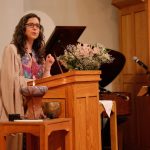
Rev. Darcey Laine
Through the years the Religious Education program has been the life-blood of the church. In the 1990s the number of children enrolled in RE grew steadily, the youth group was reestablished and thrived, and adult RE classes were reinstated. Edith Parker served as Religious Education Director from 1988 to 1998. The Reverend Til Evans was Interim Minister of Religious Education from 1998-99 and in 2000 UUCPA made a major commitment by calling the Reverend Darcey Laine as the settled Minister of Religious Education. Although the first several years with two full-time, settled ministers were rocky, by the time Rev. Laine left UUCPA in 2007, the position was solidly established.
Religious Education and Music: Centering the Community
Committees work with the Minister of Religious Education to plan and implement programs for children, youth, and adults. In 1998-99, the congregation played a leading role in developing a district-wide Coming of Age program for youth in grades 8-10, and the congregation’s teens were active in the biennial program for several rounds. The annual youth-led service continues to be one of the most popular services of the year. Offerings in adult religious education are led by members, a minister, a team of both, or guests from outside the congregation who are experts in their fields.

Early Choir
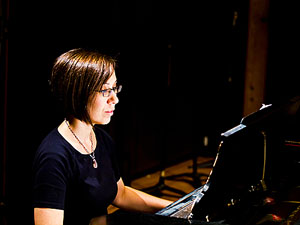
Music continues to be an extremely important part of the worship experience. Our choir was formed in 1955 and since the 1990s, has been a group of 20-30 voices most Sundays. Recent directors have been Alva Henderson (1990s). Michael Paul Gibson (September 2001-May 2004), Henry Mollicone, and, beginning in 2001, Bruce Olstad. Veronika Agranov-Dafoe joined our staff in 1992; she is an accomplished pianist who not only accompanies the choir and congregational hymns, but also serves frequently as a soloist in our outstanding Sunday morning guest musician program.
The 21st Century: Building a Church Continued
The congregation has completed a major building renovation. In 1999, a capital drive raised over one million dollars in pledges to fund a new administration building, replace the building where the youth group and others hold meetings, and renovate existing buildings. Unfortunately, in order to get a permit from the City of Palo Alto, we needed significantly greater resources to meet city requirements such as new fire hydrants and a new drainage system for the parking lot. In 2003, the congregation decided to defer construction on new buildings and use the money in the capital fund to change the configuration, improve and renovate existing buildings. In the midst of the normal chaos of construction our congregational administrator, Barbara George died very suddenly, adding poignancy to our May 2004 celebration of the renovation’s completion.

A Commitment to Two Full-Time Ministries
Rev. Amy Zucker Morgenstern
In 2001, the Reverend Ken Collier decided to leave UUCPA and accept the call to be the settled minister of another congregation. After a two-year interim ministry of the Reverend Kurt Kuhwald, in May of 2003 UUCPA voted to call the Reverend Amy Zucker (now Amy Zucker Morgenstern) to be its fifth settled parish minister.
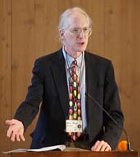
In religious education ministry, after Darcey Laine’s departure the Rev. Eva Českava was our interim–with her recommendation a part-time Religious Education assistant was added to the staff–and in fall of 2009 the Rev. Daniel Harper was hired, first as the Assistant, and a few years later as the Associate, Minister of Religious Education.
Community Warmth and Spiritual Deepening
In the 2000s, we made some changes, each of them small in itself but adding up to closer relationships among members and greater sharing among us of our diverse spiritual perspectives.
Observing that groups such as the Forum and Covenant Groups had benefited greatly from having articulated an agreement about how to be together, leaders proposed a Relational Covenant for the congregation. It passed easily and is now read aloud at every new-member welcome and congregation-wide meeting.
Second Sunday Lunch helped create a monthly gathering, and was soon joined by the more casual Fourth Sunday Brunch between the two services to provide a similar connection for the attendees of the early service.
Changes in the service included a retooled greeting time that created a warmer welcome for newcomers and a closing benediction that built a sense of community. A Membership Engagement Coordinator position was added in 2018 and the first MEC, BJ Wishinsky, quickly became an important point person in our work to more proactively welcome newcomers and integrate new members, and to help us pivot to online ministry during the COVID pandemic. John Wright stepped into the MEC position in summer 2021.
Also during these years, led by the Adult Religious Education Committee (which offered programs specifically focused on spiritual practices and articulating what we mean by spirituality), the congregation has become more comfortable with increasingly open conversation among us about our religious questions and concerns.
Social Justice: Within and Beyond
UUCPA’s involvement with affordable housing and services to homeless people deepened in the early years of the 21st century, as we added Heart and Home to Hotel de Zink as an annual rotating shelter, and enthusiastically volunteered of our parking lot as a site in Move Mountain View’s Safe Parking program.
Dan Harper urged our expansion of Our Whole Lives offerings and our facing outward to make them available to the wider community as part of our mission. The Ecojustice Camp he now leads each June has also served children and families beyond the congregation as well as within.
A slow building of activity around racial justice accelerated, as it did in many majority-white communities, through the 2010s due to the media attention on the killings of Michael Brown and numerous other unarmed people of color. In 2020, a few streams converged: Amy Morgenstern’s proposal of a group for white people intent on unlearning racism and dismantling white supremacy; several members’ activism with organizations focused on countering voter suppression, supported by UU the Vote; and the murder by Derek Chauvin of George Floyd in Minneapolis. The congregation is now applying a steady focus to these social problems, helped by increased resources from the Unitarian Universalist Association, the City of Palo Alto, and the Transforming Hearts Collective.
UUCPA Timeline, 1947-2022
1947 — On April 6, Rev. Delos O’Brian of the American Unitarian Association holds the first meeting of the emerging congregation; some present at the first meeting were members of the old Unitarian Church of Palo Alto
1947 — Rev. Nat Lauriat, minister in San Jose, drives up each week to preach in Palo Alto
1948 — The first Sunday school is a cooperative venture with Palo Alto Friends Meeting; former Unitarian Josephine Duveneck is one of the teachers
1948 — The new congregation applies for membership in the American Unitarian Association (AUA) as the Palo Alto Unitarian Society
1949 — From April through June, Rev. Lon Ray Call, extension minister from the AUA, serves the new congregation; membership more than doubles
1949 — After Nat Lauriat turns them down, the congregation calls Rev. Felix Danford Lion as minister; Lion arrives in September
1950 — Services are held at the Palo Alto Community Center
1950 — PAUS hold first Flower Communion service
1951 — The congregation changes its name to the Palo Alto Unitarian Church (PAUC)
1951 — The congregation purchases a house for Rev. Dan Lion and his family to live in
1952 — Following the lead of the Los Angeles Unitarian church, PAUC refuses to sign California’s “Loyalty Oath,” and has to pay state tax even though it’s a nonprofit
1952 — The Forum is started by Dr. Robert C. North of Stanford, for open discussion of controversial questions of the day
1953 — PAUC, the San Jose Unitarian church, and the Los Gatos Unitarian Fellowship form a dental loan fund to aid children of migrant workers
1954 — PAUC purchases property at 505 Charleston Rd. for $30,060 [$300,000 in 2020 dollars]
1954 — Women’s Alliance raises $1,326 for PAUC [$13,000 in 202 dollars]
1954 — A second service is added at 9:30 a.m.
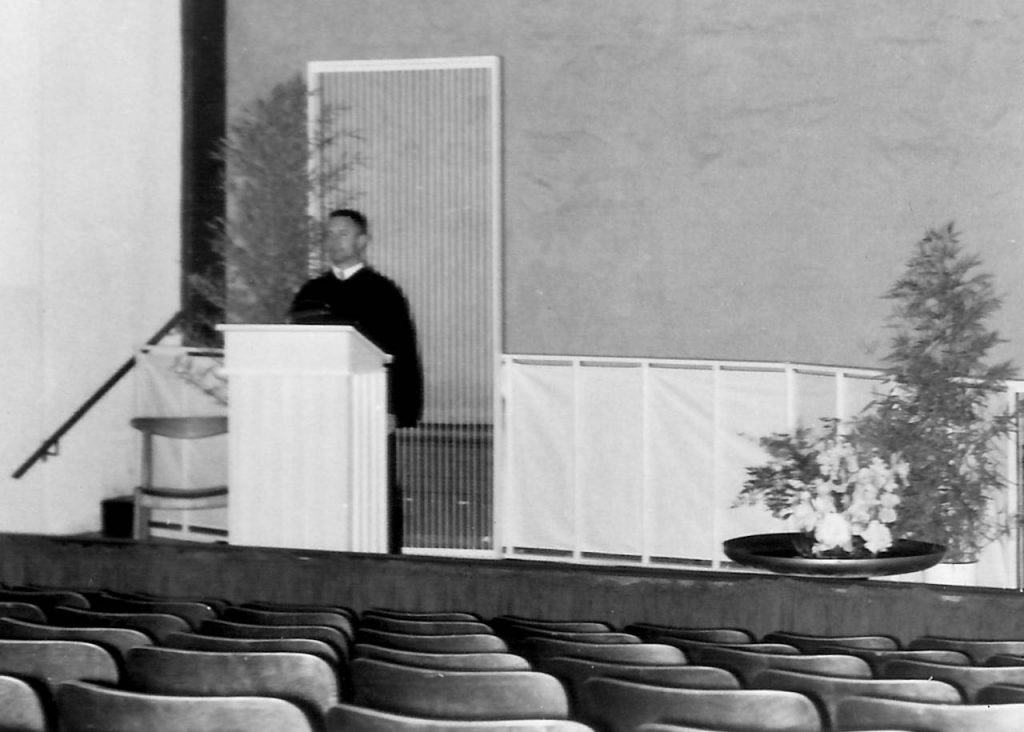
1955 — The choir sings for the first time in a PAUC service
1955 — PAUC no longer needs financial assistance from the AUA
1956 — Prominent Bay Area architect Joseph Esherick is chosen to design PAUC’s new buildings
1956 — Religious education enrollment is over 400, with waiting lists to get in
1956 — Emma Lou “Timmy” Allen becomes PAUC’s first choir director
1957 — PAUC raises $83,850 for the Building Fund [$783,000 in 202 dollars], and negotiates a bank loan for $90,000
1957 — PAUC assists a displaced persons family from East Germany
1957 — Rae Bell begins serving as children’s choir director
1958 — Ground-breaking ceremony at 505 Charleston Rd.; total cost of the new building, $178,000 [$1.6 million in 2020 dollars]
1958 — First Sunday services are held in new building
1958 — The Bookstore has its own space in the new building
1958 — San Mateo Unitarian church gives PAUC two redwood trees which are planted by the entrance drive
1958 — A madrone branch from Maj. Todd’s land on Skyline Drive is installed in the Main Hall
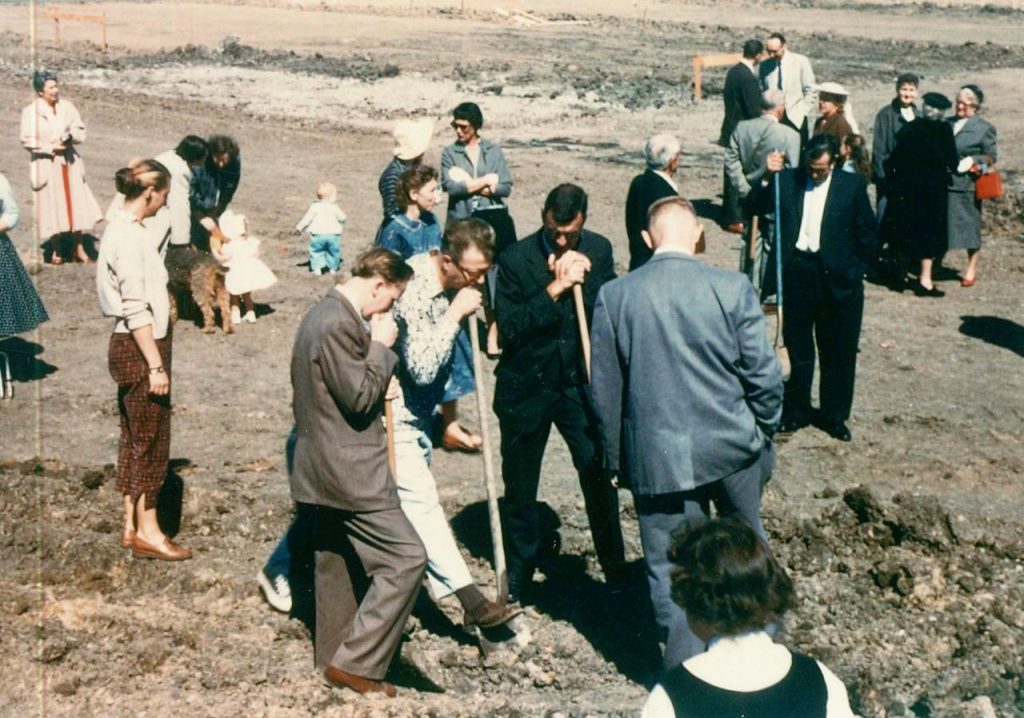

1959 — Congregation votes to support a spin-off group from PAUC which becomes the Unitarian Fellowship of Redwood City
1959 — C. Sargent Hearn, the first full-time salaried religious educator, is hired
1959 — Public address system is installed in Main Hall
1960 — Florence Sund becomes the Director of Religious Education
1960 — Main patio is finally paved
1960 — Congregation votes 75 to 1 to support the proposed consolidation of the Unitarians and the Universalists
1960 — PAUC assists a displaced persons family, plus four children from Indonesia
1961 — Women’s Alliance raises $4,590 for enlarging and paving the rear parking area [$403,000 in 2020 dollars]
1961 — Rev. D. Roen “Bud” Repp becomes assistant minister; Rev. Dan Lion goes on sabbatical for six months
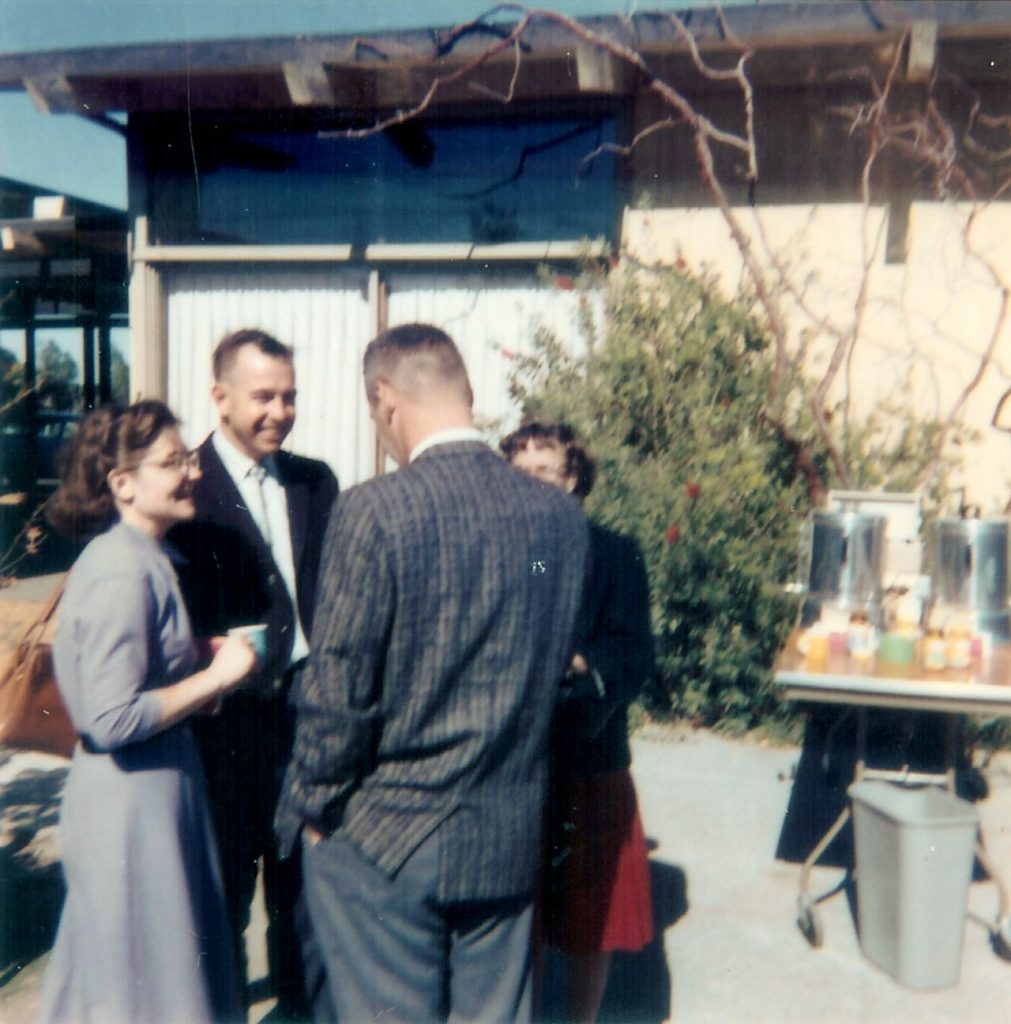
1962 — Wooden benches are installed in the main patio
1962 — Madrone branch from the Santa Cruz Mountains is installed on the wall of the Main Hall; it replaces a smaller one
1962 — Sunday school enrollment peaks at over 600; there are three Sunday services to accommodate the Sunday school
1962 — Congregation supports the spin off of the Sunnyvale UU Fellowship from PAUC
1963 — Choir has 50 members; Dr. Arthur P. Barnes, Stanford Music Professor, becomes choir director
1963 — Sunnyvale Fellowship is in operation; over the next two years, 100+ children transfer there, relieving pressure on PAUC’s Sunday school
1963 — Musician Jerry Garcia and Sara Ruppenthal marry in the Main Hall with Rev. Dan Lion officiating
1964 — Rev. Dan Lion participates in the Mississippi Summer Project (a.k.a. Freedom Summer), and is supported by PAUC
1964 — 100 junipers are planted in front of the Main Hall
1964 — Minister’s study is added to the rear of the office building
1964 — PAUC gives $2,000 [$17,000 in 2020 dollars] to the Redwood City Fellowship so they can hire a minister
1964 — Rev. Dan Lion officiates at a wedding ceremony for musicians Mimi Baez and Richard Fariña (they had been legally married in Paris a few months before)
1965 — PAUC supports Rev. Dan Lion’s trip to Selma, Ala.
1965 — Mike Young becomes assistant minister; congregation ordains and installs him in November
1965 — Congregation votes to investigate the possibility of building a larger church building at the front of the lot
1965 — Nationwide, Unitarian Universalism stops growing and begins declining around about 1965
1966 — PAUC sells 2.2 acres to Stevenson House elderly housing community at below market rates, then gives Stevenson House a $5,000 donation [$405,000 in 2020 dollars]
1966 — Activism against the Vietnam War
1967 — Clarice Gault hired as new Director of Religious Education
1967 — Revs. Dan Lion and Mike Young provide counseling to conscientious objectors
1968 — Congregation votes to not build a new church building, and instead votes to spend the money on “human rights” programs (however, some voted against building because they thought the design was ugly)
1968 — Rev. Mike Young resigns as of Dec. 31, 1968, and is not replaced
1968 — Stevenson House construction is completed, including the bridge linking Stevenson House with PAUC
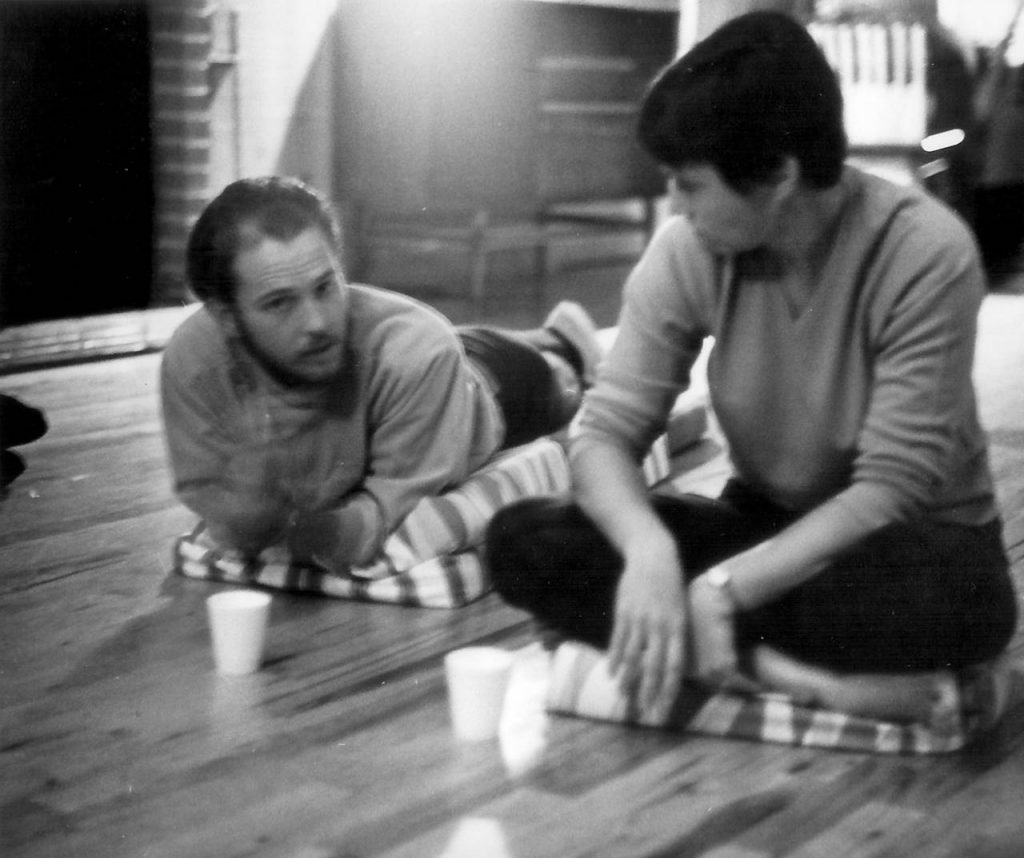
1969 — Covered patio building is completed for $13,000 [$93,000 in 2020 dollars]
1969 — Due to falling adult attendance and religious education enrollment, PAUC goes down to two services per Sunday
1969 — Virginia Stephens and Ellen Thacher become co-DREs
1969 — Rev. Dan Lion and other Unitarians participate in anti-war march in downtown Palo Alto
1970 — PAUC forms a nonprofit corporation to start an alternative high school, called “Lothlorien High School”
1970 — Ron Garrison hired as “Youth Minister”
1970 — The congregations declines to invest in Black Affairs Council bonds
1970 — Rae Bell resigns as children’s choir director
1970 — Congregation declines to add “Universalist” to its name, at the requests of Universalists in the congregation
1971 — PAUC establishes a day care center, still in existence,which is named after the recently deceased Ellen Thacher
1971 — PAUC calls Rev. Dr. Ron Hargis as minister of religious education
1972 — Rev. Dan Lion resigns; Rev. Ron Hargis becomes sole minister until Rev. Sidney Peterman arrives in the fall as interim minister
1972 — PAUC grants to use of the church as sanctuary for those “acting according to the dictates of their conscience in opposition to civil of military actions” [i.e., for conscientious objectors]

1973 — PAUC votes to call Rev. William Jacobsen to serve as co-minister with Ron Hargis
1973 — A live-in custodian is hired, living in what is now the Choir Room
1973 — Women’s Alliance disbands, donates their remaining money to charity
1973 — The son of musician Joan Baez attends Thacher Children’s Center
1974 — “Stagflation” reduces income and increases expenses; the “Baby Bust” means fewer children; as a result PAUC shrinks financially and numerically
1974 — A grant makes it possible for 6th and 7th graders to participate in an art project for an afternoon with innovative artist Ruth Asawa
1975 — The Social Concerns Committee supports the United Farm Workers boycott of Gallo
1975 — After its sixth year, Lothlorien High School ceases operations
1976 — The house purchased for use by the minister (the “parsonage”) is sold
1977 — Rev. Ron Hargis and Rev. William Jacobsen promise to resign effective Jan. 1, 1978, if finances don’t improve; when finances don’t improve, Hargis resigns, but Jacobsen does not
1977 — Gail Hamaker and other PAUC women are active in getting the Unitarian Universalist Association General Assembly to adopt the groundbreaking Women and Religion resolution
1978 — Religious education enrollment rises from 50 to 100 with leadership from DREs June and Bob Donmoyer
1978 — First annual “mini-vacation” at Bass Lake
1978 — Women and Religion resolution: PAUC votes to examine sexist religious beliefs, but declines to examine sexist language and actions

1979 — For the first time, PAUC offers a preschool class in Sunday school
1980 — DRE Mary Brau also becomes “executive officer” of the entire church
1980 — A women’s group, based on the Women and Religion resolution, is formed and given Board sanction
1980 — Nationwide, after a decade and a half of decline, Unitarian Universalism begins to grow at about 1% per year
1981 — The World Concerns Committee presents non-partisan lectures on various topics of social concern
1982 — Congregation votes in December to join South Bay Sanctuary Covenant to provide protection and advocacy for Central American refugees
1982 — Mary Brau resigns as DRE
1982 — Men’s group forms, with a dozen men meeting Monday evenings
1982 — Steel posts and chains are installed at entrance and exit drives to reduce vandalism
1982 — Congregation votes to remove sexist language from bylaws

1983 — 25th anniversary celebration; Rev. Dan Lion speaks at the celebration
1984 — The Sanctuary Committee raises $100 a month to support South Bay Sanctuary Covenant [$250 in 2020 dollars]
1984 — The Stevenson House Committee helps raise funds to renovate Stevenson House, arranges activities to “enliven the environment” of residents
1985 — Caring Network is organized to be “available to those of us in emergency situations”
1985 — The Social Action Committee is temporarily inactive, but it did distribute funds to South Palo Alto Food Closet and other groups
1986 — Wall paneling and track lighting installed in the Main Hall Lobby for art exhibits
1986 — PAUC UUYAN, a young adult group for people ages 18 to 35, meets nearly weekly
1987 — Congregation votes to join the Mid-Peninsula Peace Center
1987 — Congregation votes to make PAUC a Nuclear Weapons Free Zone
1987 — Congregation votes to join the Urban Ministry of Palo Alto, to address homelessness

1988 — Congregation votes to change name to the Unitarian Universalist Church of Palo Alto (UUCPA)
1988 — UUCPA is a founding member of Hotel de Zink, a short-term homeless shelter
1988 — Edith Parker becomes Director of Religious Education
1989 — Friendship Bridge linking UUCPA and Stevenson House is built
1989 — The Board of Trustees meets just two hours after the Loma Prieta earthquake
1989 — PAUC purchases its first computer, a Mac IIcx
1989 — Congregation votes that Bill Jacobsen shall retire no later than August 31, 1990
1990 — Rev. Sam Wright becomes interim minister
1990 — Rev. Sam Wright’s wife, Donna Lee, writes a history of the old Unitarian Church of Palo Alto (1905-1934)
1991 — Rev. Ken Collier is called as minister
1991 — Main Hall is often 80-90% full on Sunday mornings; Ken Collier first proposes double sessions
1992 — A new madrone branch from the Santa Cruz Mountains is installed in the Main Hall; this is the third branch to hang in the Main Hall
1992 — UUCPA joins with three other UU congregations to form a congregation in Fremont

1993 — The large hanging quilt banners, made by fabric artist Wendy Hill, are installed in the Main Hall
1993 — Congregation votes to name Dan Lion as Minister Emeritus
1993 — “Caring and Sharing” added to Sunday service
1994 — Overgrown trees are removed from the back lawn in front of Rooms 11, 12, and 13 (now Rooms A, B, C, and D)
1994 — Bequest of $340,000 received from the estate of Dorothy B. White [$600,000 in 2020 dollars]
1995 — UUCPA votes to include a non-discrimination clause in the bylaws
1995 — UUCPA votes to provide up to $10,000 [$17,250 in 2020 dollars] to the new UU congregation in Fremont
1996 — “An Easter Egg Hunt was created for children of preschool through 2nd grade.”
1997 — UUCPA joins with other churches to form Peninsula Interfaith Action
1997 — Congregation sees enough growth in membership to consider adding a second minister
1997 — Anti-Racism Task Force is formed
1997 — UUCPA commissions sculptor Bennet Sykes Blackburn to make a wooden chalice
1998 — UUCPA hires Rev. Til Evans as interim minister of religious education, to serve with Ken Collier
1998 — Ellen Thacher Preschool is now part of Palo Alto Community Child Care
1998 — UUCPA votes to support community minister Rev. Erinn Melby for three years, our first community minister
1999 — A capital campaign is begun, with the goal of a new administration building
1999 — UUA recognizes UUCPA as a Welcoming Congregation,welcoming to LGBTQIA+ people

2000 — In January, UUCPA adds a second worship service on Sunday morning
2000 — Rev. Darcey Laine is called as minister of religious education
2000 — Live-in custodian resigns and is not replaced
2001 — Rev. Ken Collier resigns to become minister in Santa Barbara
2001 — Proposed building project will cost $1.82 million, more than the congregation can raise [$2.78 million in 2020 dollars]
2001 — Rev. Kurt Kuhwald starts as interim minister, just before 9/11

2002 — A Building Committee is formed, with a new lower budget of $686,000 [$1 million in 2020 dollars]
2003 — Rev. Amy Zucker is called as parish minister, to serve as co-minister with Darcey Laine
2003 — UUCPA adopts a statement of conscience opposing a preemptive strike by the U.S. on Iraq
2004 — Rooms 11-13 renovated as Rooms A-D (1 classroom and 3 offices); new restrooms added; office and library reconfigured
2004 — UUCPA votes to reaffirm its support for marriage equality
2004 — The Senior High Youth Group and Darcey Laine, along with youth from the Redwood City Fellowship, install the first labyrinth at UUCPA
2005 — New sound system installed in the Main Hall
2005 — Parking lot resurfaced
2005 — Rev. Amy Zucker marries, becomes Amy Zucker Morgenstern
2006 — Congregation adopts a relational covenant
2006 — Wifi installed in the Fireside Room and most classrooms
2007 — 60th anniversary celebration, Rev. Dan Lion speaks
2007 — Rev. Darcey Laine resigns, as her family wants to relocate to upstate New York
2007 — Rev. Eva Ceskava becomes interim minister of religious education
2008 — Til Evans garden is completed
2008 — Hearing aid loop system in Main Hall improves accessibility for persons who are hard of hearing
2008 — Welcoming Congregations Committee organizes congregation to defeat Prop 8, a ballot measure to ban same-sex marriage
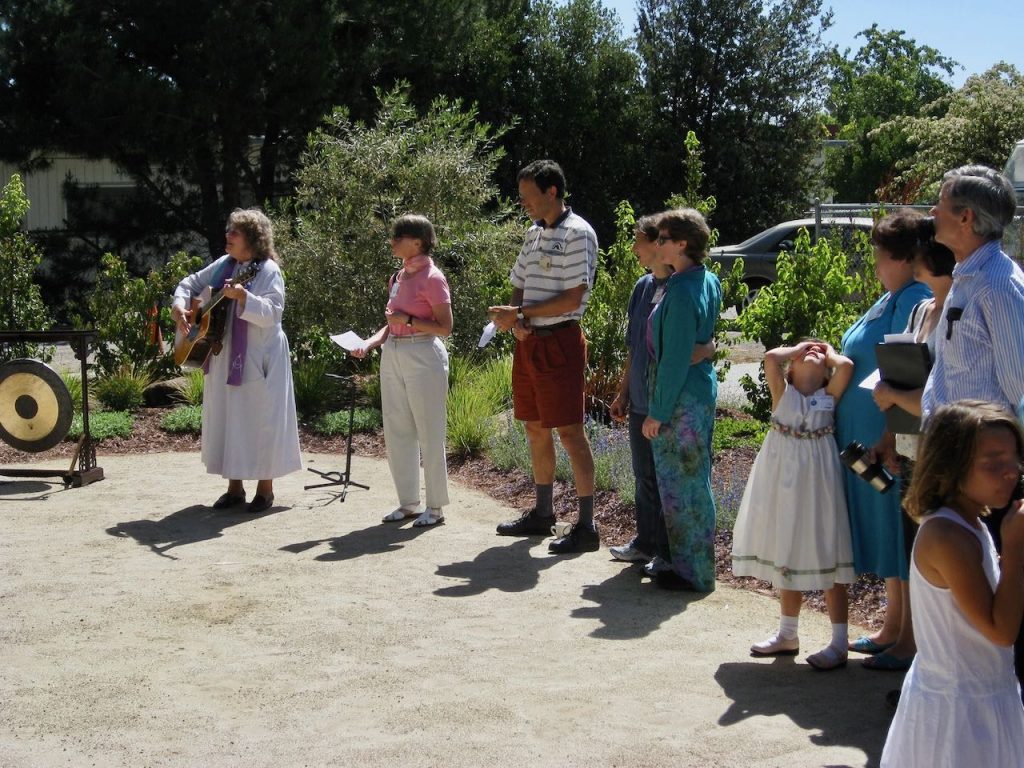
2009 — Congregation hires Rev. Dan Harper as assistant minister of religious education
2009 — Church consultant Alice Mann suggests bringing the congregation together more often, inspiring Second Sunday Lunches to begin
2009 — Nationwide, Unitarian Universalism begins small annual decline that continues to the present
2010 — With the help of church consultant Alice Mann, UUCPA sets goal of “adding the next 50 people” as measured by average annual attendance
2010 — Rev. Sean Parker Dennison serves as sabbatical minister, UUCPA’s first transgender minister
2011 — Solar panels installed on the roof of the Main Hall, providing about half of UUCPA’s energy needs
2011 — New fenced-in play area installed in front of Thacher School’s playground
2011 — Bruce Olstad becomes Music Director
2011 — Congregation votes to endorse single payer health insurance for California
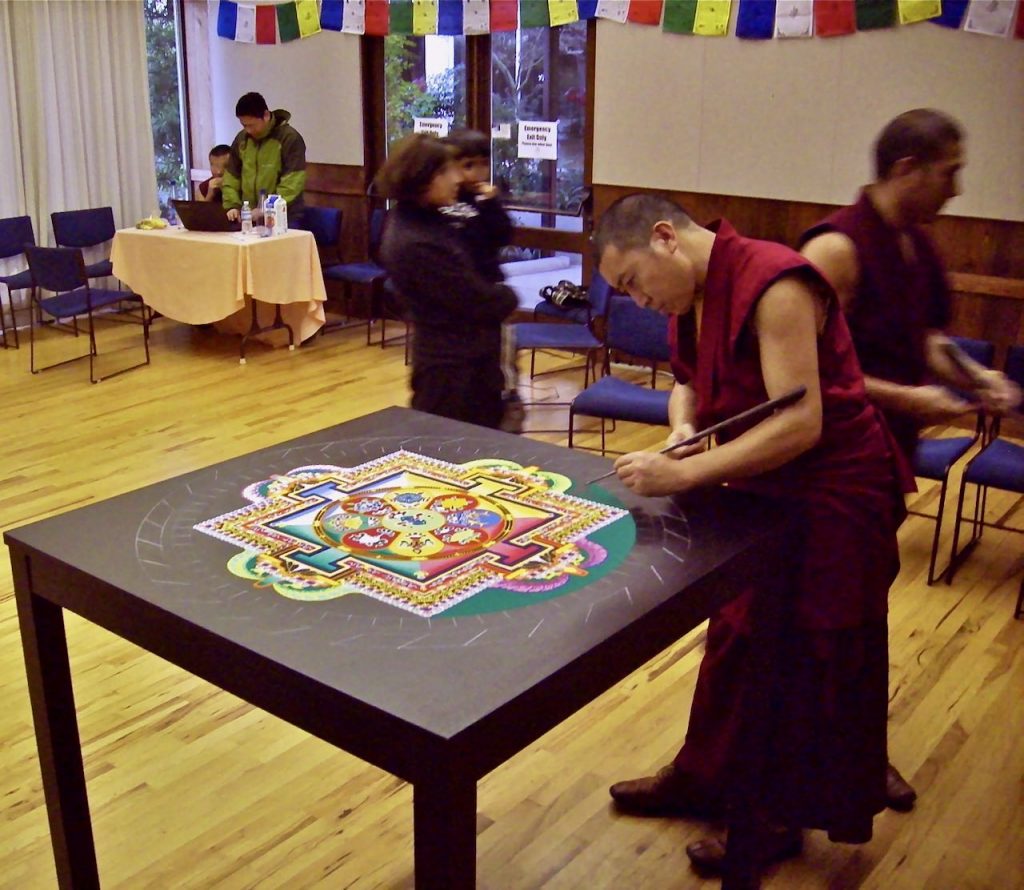
2012 — Energy efficient LED lights installed in the parking lot
2012 — Our Whole Lives comprehensive sexuality education classes are open to the wider community
2012 — Navigators program is organized at UUCPA, providing scouting that welcomes all genders and LGBTQIA+ persons
2013 — Board of Trustees transitions to using an online document filing system
2013 — UUCPA moves membership database to a cloud-based system
2013 — Music Director Bruce Olstad launches Bodhi Tree North concert series to raise money for charitable causes
2014 — The front of the lot is landscaped, junipers removed, and a native plant garden and a larger labyrinth are installed
2014 — Religious education enrollment peaks at 135
2014 — Sunday school “Ecojustice class” installs first rain barrel at UUCPA
2015 — UUCPA provides meeting space and use of our kitchen to Stevenson House, while their buildings are renovated
2015 — Congregation votes to ordain UUCPA member and hospital chaplain Melissa Thompson
2016 — Board prohibits smoking on campus
2016 — Membership and Growth Committee reports that UUCPA is halfway to the goal of adding 50 people, as measured by average annual attendance
2017 — UUCPA adds more solar panels to Main Hall roof, which now produce all the congregation’s electrical needs
2017 — UUCPA leases the parking lot to a solar energy company to erect a solar panel array
2017 — Staff cut-backs due to attrition save UUCPA money
2017 — UUCPA moves website to WordPress CMS
2018 — UUCPA begins hosting Heart and Home Collaborative, a women’s homeless shelter, for 6 weeks each winter
2018 — A Membership Engagement Coordinator is hired for 15 hours per week, on a one-year trial basis
2018 — Congregation considers removing the word “Church” from its name, but confronted with 5 possible new names, none receives the necessary 2/3 majority
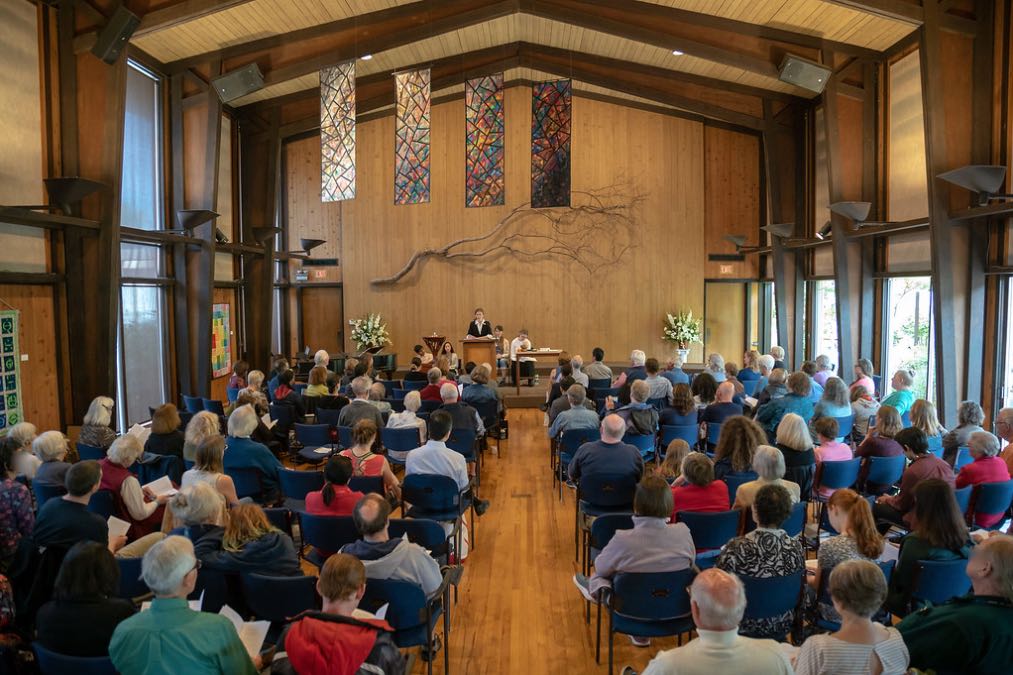
2019 — Rising health insurance costs prompt Board of Trustees to create innovative funding scheme that maintains insurance coverage while lowering costs
2019 — About 30% of enrolled children and youth are non-white
2020 — COVID cause state-wide shutdown, UUCPA moves worship services and programs online, congregation members respond with creativity and resilience
2020 — Due to COVID lockdown, Heart and Home homeless shelter remains at UUCPA for 3 months, 24/7
2020 — UUCPA receives federal Paycheck Protection Plan loan to help cover payroll during COVID
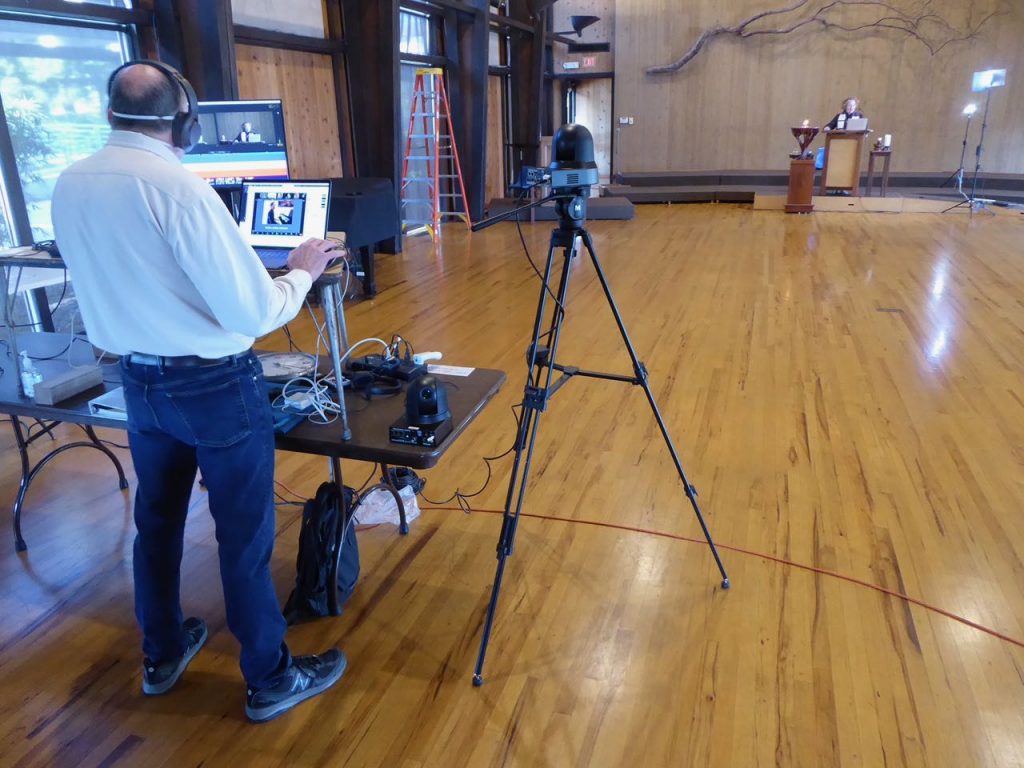
2021 — In the Main Hall, Worship Tech crew upgrades audio board and adds 3-camera video and large video screens, to allow multi-platform livestreaming capability
2021 — Of 99 people responding to a congregational survey, roughly 15% are non-white
2021 — UUCPA begins hosting a Safe Parking Program, where up to four homeless families can live in their cars
2022 — UUCPA celebrates its 75th anniversary!
Timeline researched by Rev. Dan Harper
Updates: (1) 2021-11-14: corrections and additions to timeline; (2) 2021-11-15: added approximate constant dollar values; (3) 2021-12-09: began adding vintage photos.
UUCPA Social Justice Timeline
1949 — Our congregation protests “the assumption that war is inevitable and an A-bomb justified…. We urge positive program negotiations to avoid war.”
1950 — Congregation gives sizable contributions to help Spanish refugees who had been living in France since 1938
1950 — Congregation sponsors and settles a Displaced Persons family from Latvia
1952 — Congregation refuses to sign California’s “Loyalty Oath,” and has to pay state tax even though it’s a nonprofit
1952 — Congregation collects 155 pounds of clothing for Spanish refugee children
1953 — Our congregation, the San Jose Unitarian church, and the Los Gatos Unitarian Fellowship form a dental loan fund to aid children of migrant workers
1956 — Congregation assists a displaced persons family from East Germany
1958-66 — With a group of 5 Bay Area Unitarian churches, our congregation helps found Stevenson House, Palo Alto’s first nonprofit housing for low-income seniors
1958 — Over 200 members sign a pledge of open housing, agreeing to welcome all persons to their neighborhood regardless of race, creed, or national origin
1959 — Congregation supports a Displaced Persons family from East Germany
1960 — Congregation assists a displaced persons family, plus four children from Indonesia
1960 — Congregation approves a resolution calling for the dissolution of the House Un-American Activities Commission
1962 — The Women’s Alliance sends six cartons of clothing to Spanish refugees in Toulouse, France
1962 — The Sunday school packs food baskets for prisoner’s families at Christmas
1964 — Rev. Dan Lion participates in the Mississippi Summer Project (a.k.a. Freedom Summer), and is supported by our congregation
1964 — Congregation votes overwhelmingly to oppose the Becker Amendment, Resolution 693, that would allow prayer in public schools
1964 — Congregation votes to oppose California Proposition 14, which would allow open racial discrimination when selling or renting housing
1965 — Congregation supports Rev. Dan Lion’s trip to Selma, Ala.
1965 — Sunday school students give $90 [$800 in 2020 dollars] to sponsor a foster child in Greece
1966 — Activism against the Vietnam War
1966 — Congregation sells 2.2 acres to Stevenson House elderly housing community at $30,000 below market rates [$240,000 in 202 dollars], then gives Stevenson House a $5,000 donation [$405,000 in 2020 dollars]
1967 — The congregation’s newsletter carries a series of letters over several months from congregation members both opposing and supporting the Vietnam War
1967 — Senior minister Rev. Dan Lion and Assistant Minister Rev. Mike Young provide counseling to conscientious objectors
1968 — Congregation votes to not build a new church building, and instead votes to spend the money raised on “human rights” programs
1969 — Rev. Dan Lion and other Unitarians participate in anti-war march in downtown Palo Alto
1970 — Congregation forms a nonprofit corporation to start an alternative high school, called “Lothlorien High School”
1971 — Congregation establishes Ellen Thacher Children’s Center, a day care center named after the recently deceased Ellen Thacher; 1/4 of the children receive scholarships
1972 — Congregation grants the use of the church as sanctuary for those “acting according to the dictates of their conscience in opposition to civil or military actions” [i.e., for conscientious objectors]
1975 — The Social Concerns Committee supports the United Farm Workers boycott of Gallo
1975 — After its sixth year, Lothlorien High School ceases operations
1977 — Gail Hamaker and other women from our congregation are active in getting the Unitarian Universalist Association General Assembly to adopt the groundbreaking Women and Religion resolution
1981 — The World Concerns Committee presented non-partisan lectures on various topics of social concern
1982 — Congregation votes in December to join South Bay Sanctuary Covenant to provide protection and advocacy for Central American refugees
1984 — The Sanctuary Committee raises $100 a month to support South Bay Sanctuary Covenant [$250 in 2020 dollars]
1984 — The Stevenson House Committee helps raise funds to renovate Stevenson House, arranges activities to “enliven the environment” of residents
1987 — Congregation votes to join the Mid-Peninsula Peace Center
1987 — Congregation votes to make our congregation a Nuclear Weapons Free Zone
1987 — Congregation votes to join the Urban Ministry of Palo Alto, to address homelessness
1988 — Congregation is a founding member of Hotel de Zink, a short-term homeless shelter
1989 — 1st annual Undie Sunday collection of donations of new underwear for unhoused people
1992 — Congregation gives over 3% of its annual budget to the Unitarian Universalist Service Committee
1994 — Congregations begins Welcoming Congregation process, to become more welcoming to LGBTQIA+ people
1997 — Congregation joins with other churches to form Peninsula Interfaith Action; began work on education and housing
1999 — UUA recognizes UUCPA as a Welcoming Congregation,welcoming to LGBTQIA+ people
2002 — Congregation adopts Statement of Conscience opposing the Iraq war
2002 — Marriage equality activism against the Knight Initiative (Prop 22)
2003 — Congregation raises more than $50,000 for construction of the Opportunity Center to provide services to unhoused people
2003 — Founding member of Multifaith Voices for Peace & Justice
2005 — Antiwar activism against second Iraq war
2007 — Green Sanctuary Committee is formed
2008 — Task force on ridding the world of nuclear weapons is formed
2008 — Welcoming Congregation Committee organizes congregation to attempt to defeat Prop 8, a ballot measure to ban same-sex marriage
2009 — Congregation receives Green Sanctuary Congregation certification from the Unitarian Universalist Association for good congregational environmental practices
2010 — 1st annual sale of fair trade chocolate for Halloween
2010 — Fair Elections task force is formed
2011 — Congregation works on the California DISCLOSE Act with California Clean Money Campaign
2011 — Solar panels installed on the roof of the Main Hall, providing about half of UUCPA’s energy needs
2012 — Congregation endorses SB 52, the California Clean Money Act, to require financial disclosure of campaign contributions; holds CA DISCLOSE Act rally at the church
2012 — Our Whole Lives comprehensive sexuality education classes are open to the wider community
2013 — Immigration Task Force is formed; adult class is offered on “Immigration as A Moral Issue”
2013 — Music Director Bruce Olstad launches Bodhi Tree North concert series to raise money for charitable causes
2014 — Installation of native plant garden in front of the church is completed
2015 — “Drone quilts” are displayed in the Main Hall, sponsored by Multifaith Voices for Peace & Justice
2015 — Ecojustice Camp day camp is launched to teach kids about environmental justice
2015 — Congregation gives authority to the Green Sanctuary Committee to advocate on behalf of UUCPA for environmental issues
2016 — Rev. Amy Zucker Morgenstern leads first Beloved Conversations anti-racism class
2017 — Congregation endorses SB 31, California Religious Freedom Act
2017 — Congregation co-sponsors Unity Rally to counter rally by Anti-Sharia proponents
2017 — More solar panels added to Main Hall roof, which now satisfy all the congregation’s electrical needs
2018 — Congregation approves fast-track process for endorsements on behalf of the congregation, and for approvals to carry a UUCPA banner in public rallies and vigils
2018 — Parking lot solar panels, erected by a solar energy company leasing from the congregation, begin operation
2018 — Congregation becomes a host of the year-old Heart & Home Collaborative women’s homeless shelter
2018 —Native plant garden in front of the church is expanded
2019 — Signed a Statement of Support for people arrested and charged for leaving food and water in the desert for immigrants
2019 — Congregation organizes phone banks for Reclaim our Vote, reaching out to voters of color
2019 — Rev. Amy Zucker Morgenstern begins “White Folks Dismantling White Supremacy” anti-racism class
2019 — In cooperation with Grassroots Ecology, congregation becomes a rain barrel demonstration site, with over 500 gallon capacity
2020 — Congregation participates in the Unitarian Universalist Association’s UU the Vote campaign
2020 — Members of the congregation write thousands of postcards and made hundreds of phone calls to encourage people of color in southern states to register and vote in the 2020 election
2020 — Due to COVID lockdown, Heart & Home Collaborative homeless shelter remains at UUCPA for 3 months, 24/7
2020 — Board approves carbon-neutral policy
2020 — “White Folks Dismantling White Supremacy” class expanded to twice monthly
2021 — Congregation endorses the California Ballot DISCLOSE Act
2021 — Congregation receives final approval and launches UUCPA Safe Parking Program, hosting four passenger vehicles in our parking lot, in conjunction with Move Mountain View
2021 — Board approves plastics reduction policy
2021 — First all-electric heat pump HVAC system is installed in church office
2021 — Congregation begins work on proposed 8th Principle on addressing racism and other oppressions
2021 — Core group takes online Beloved Conversations class from Meadville Lombard Theological School
2021 — Congregation renews their commitment to being a Welcoming Congregation
2021 — Congregation adds Showing Up for Racial Justice at Sacred Heart as a monthly Justice Partner
Update, 11/18/21: Errors corrected, new items added
UUCPA Ministers and Religious Educators
Chronological lists of UUCPA ministers and religious educators.
Ministers
1947-49 — Rev. Nat Lauriat*, minister of First Unitarian Church in San Jose, spends a few hours each week in Palo Alto
April-June, 1949 — Rev. Lon Ray Call*, extension minister from the American Unitarian Association
1949-72 — Rev. Felix Danford “Dan” Lion*, minister
1961-1962 — Rev. Darrall Roen “Bud” Repp*, assistant minister
1965-1968 — Rev. Mike Young, assistant minister
1971-1977 — Rev. Dr. Ron Hargis*, minister of religious education
1972-1973 — Rev. Sidney Peterman*, interim minister
1973-1990 — Rev. William R. “BJ” Jacobsen*, parish minister
1990-1991 — Rev. Sam Wright,* interim minister
1991-2001 — Rev. Ken Collier, minister
1998-2000 — Rev. Dr. Til Evans*, interim minister of religious education
2000-2007 — Rev. Darcey Laine, minister of religious education
2001-2003 — Rev. Kurt Kuhwald, interim minister
2003-present — Rev. Amy Zucker Morgenstern
2007-2009 — Rev. Eva Ceskava, interim minister of religious education
2009-present — Rev. Dan Harper, assistant/associate minister of religious education
* Deceased

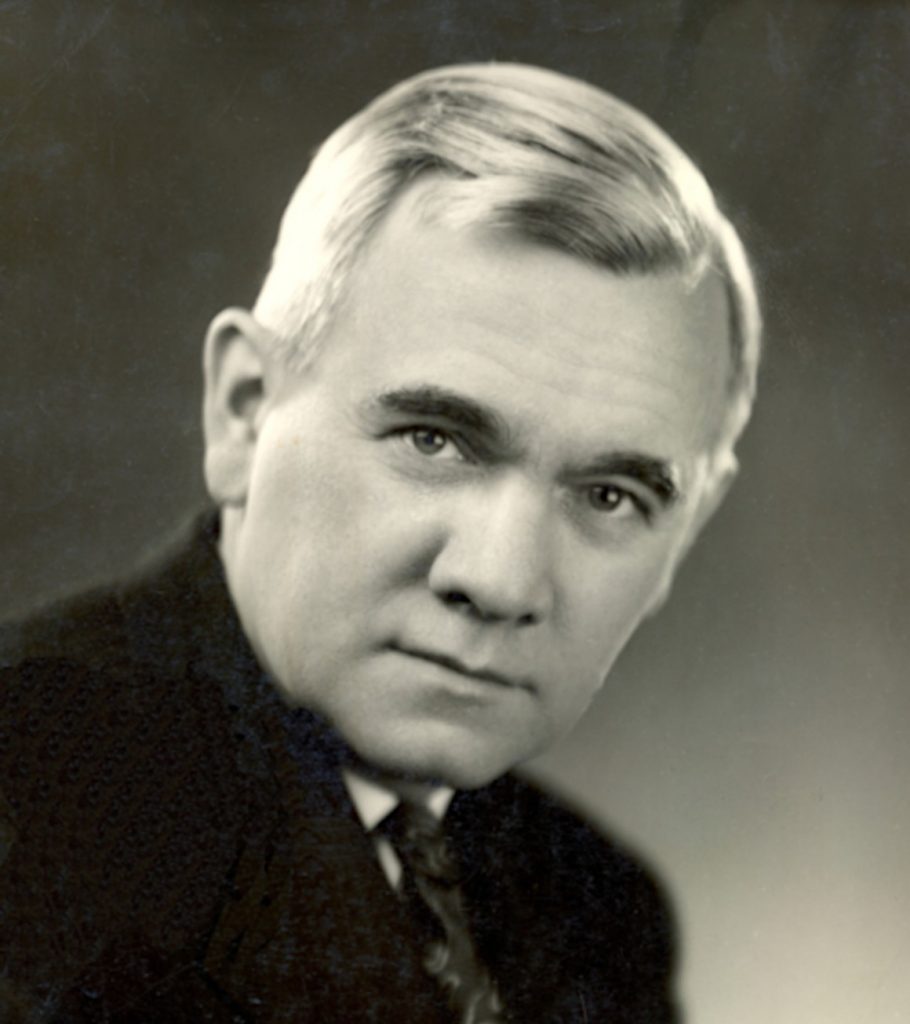
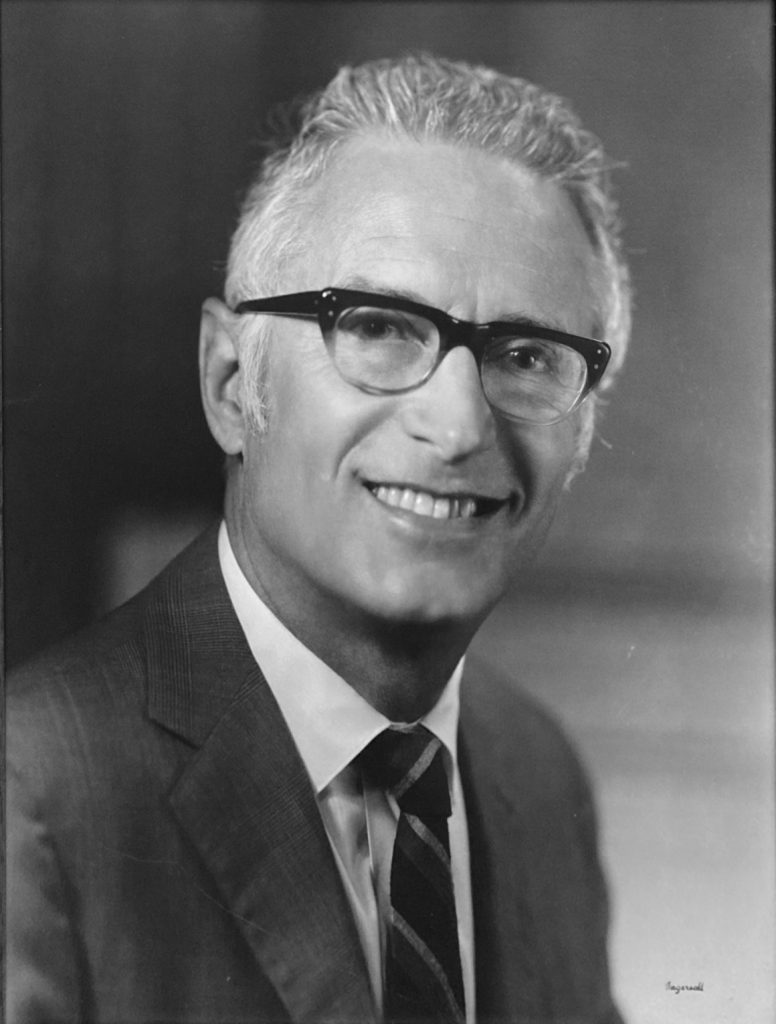
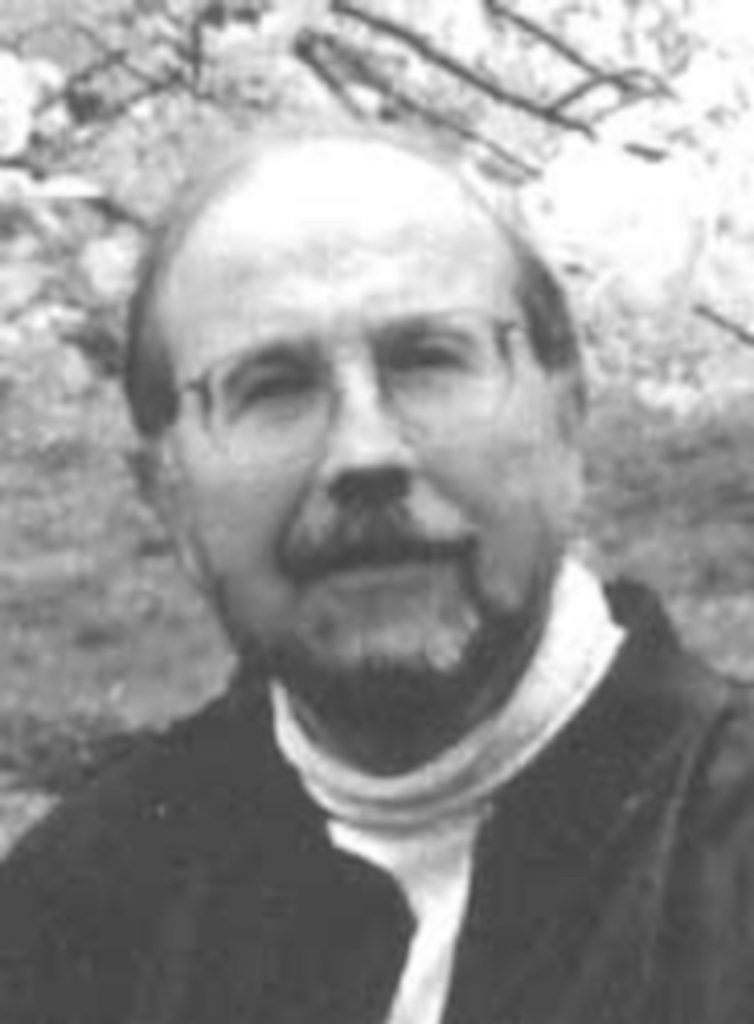
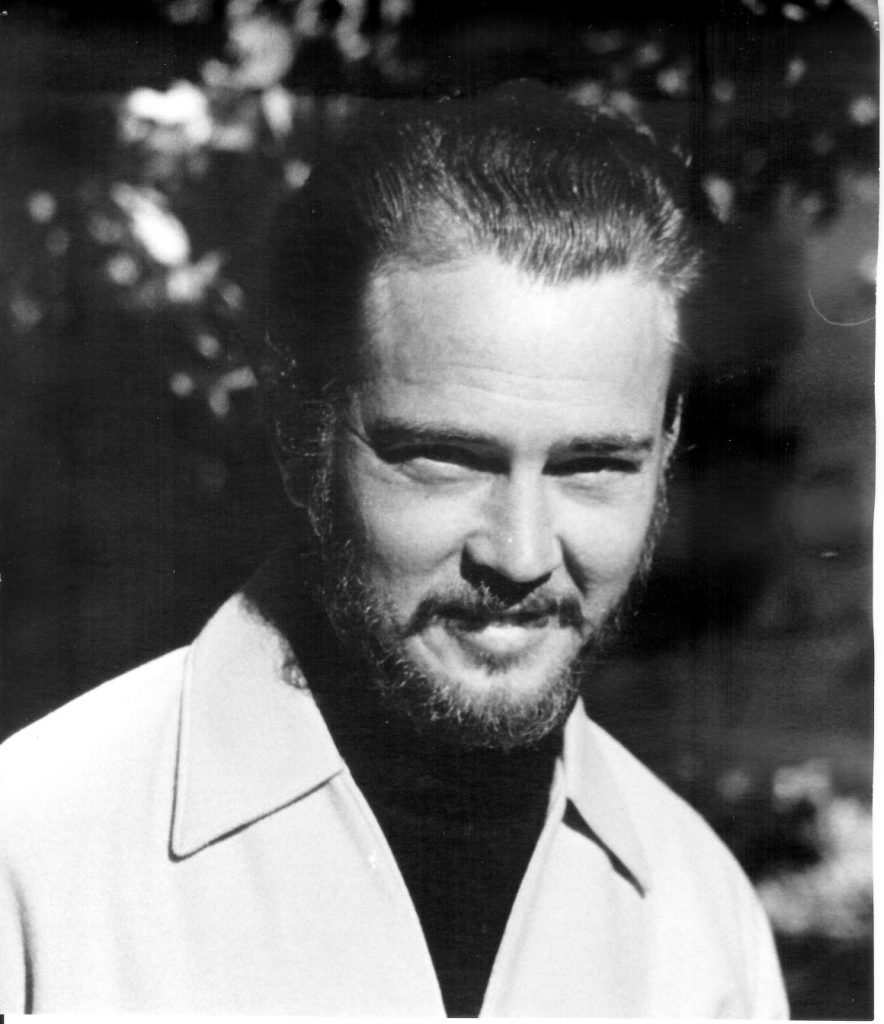

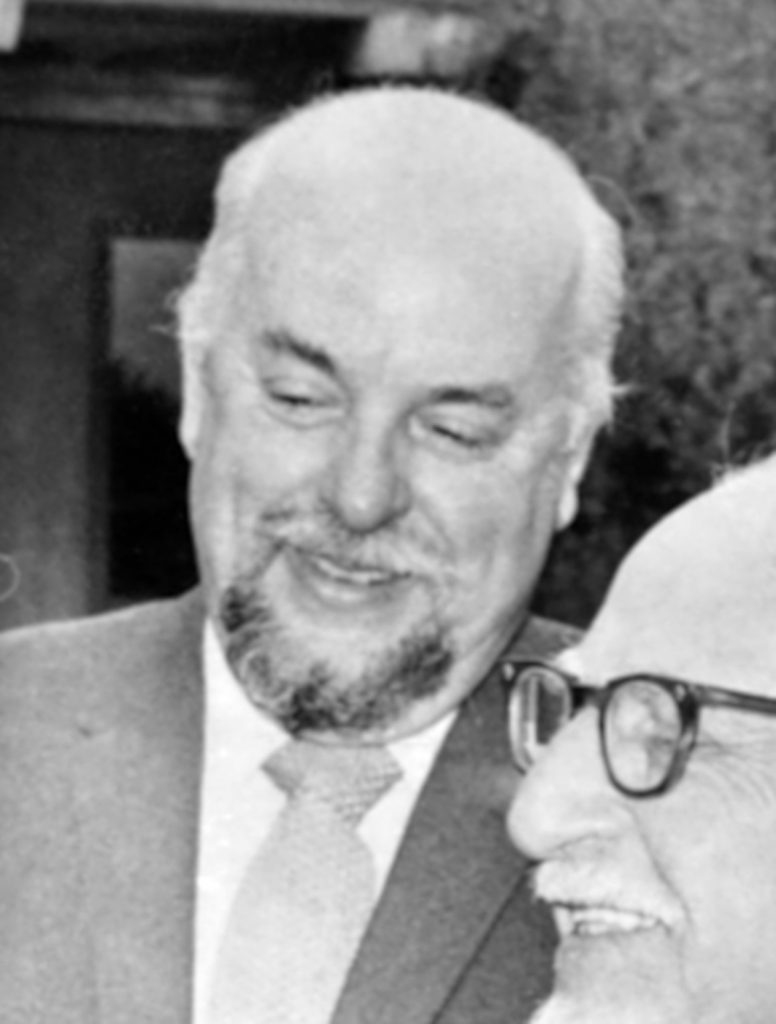
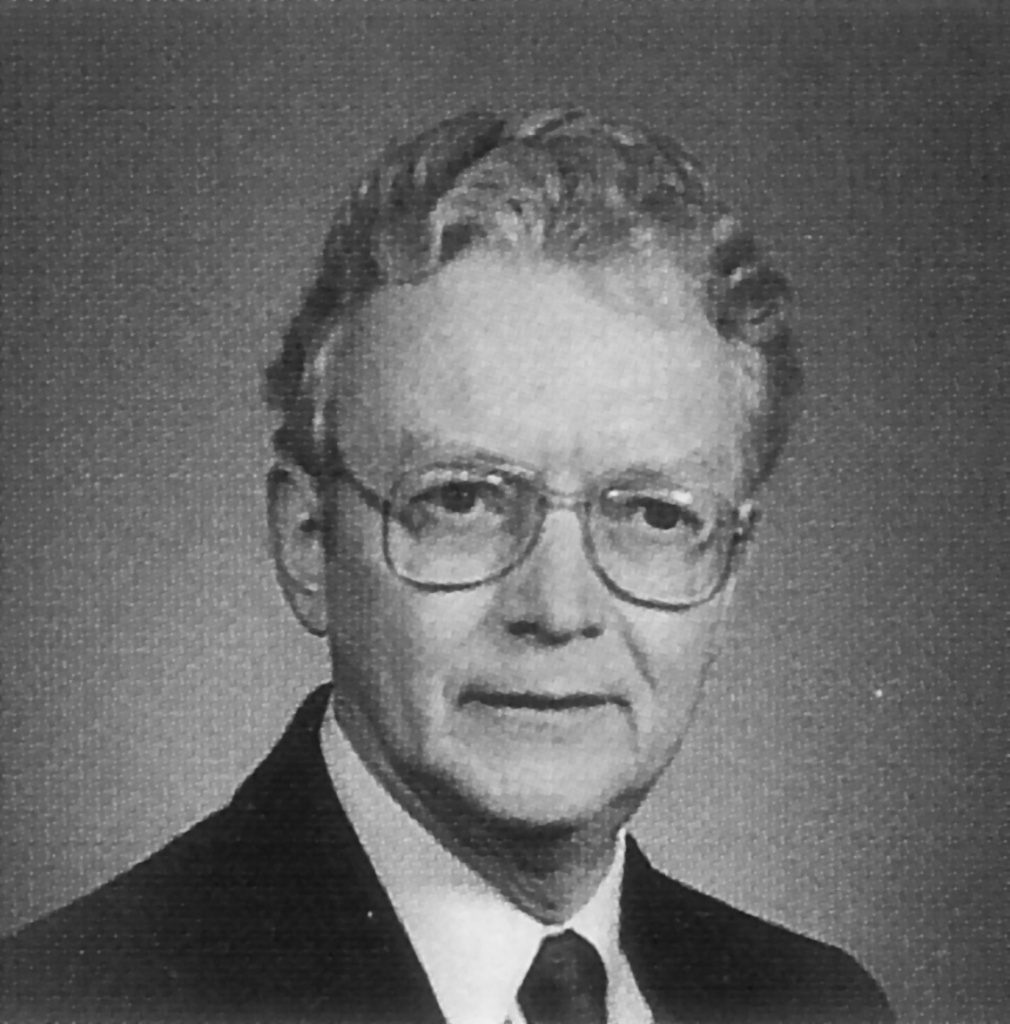



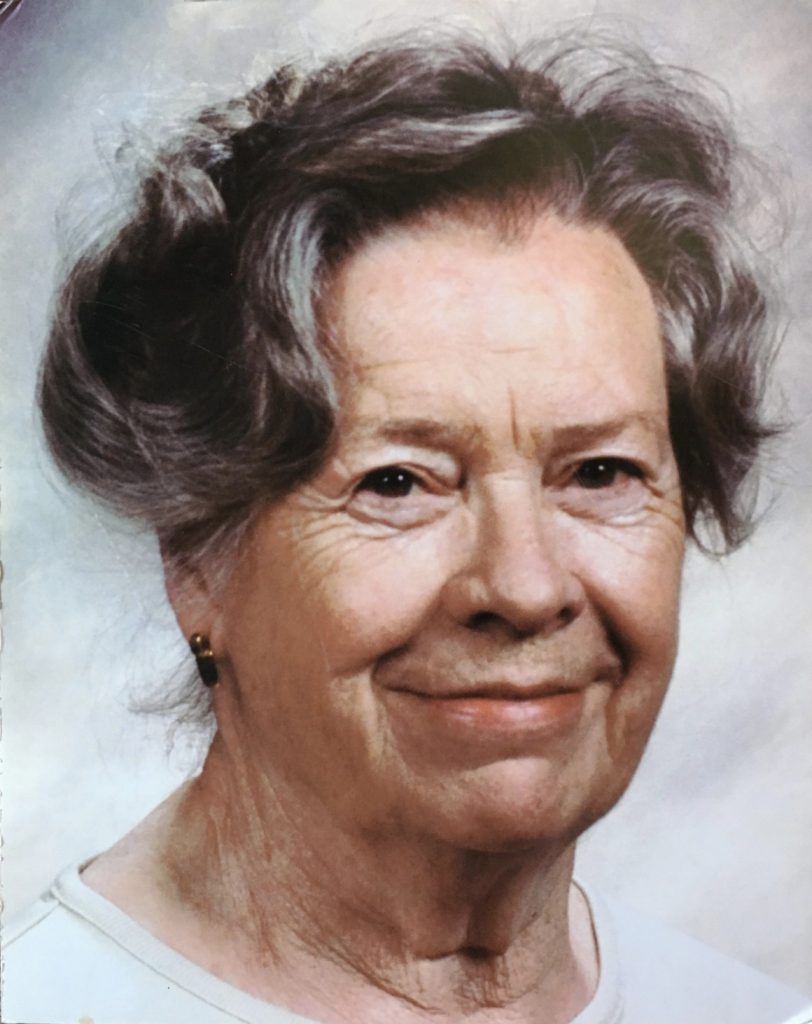

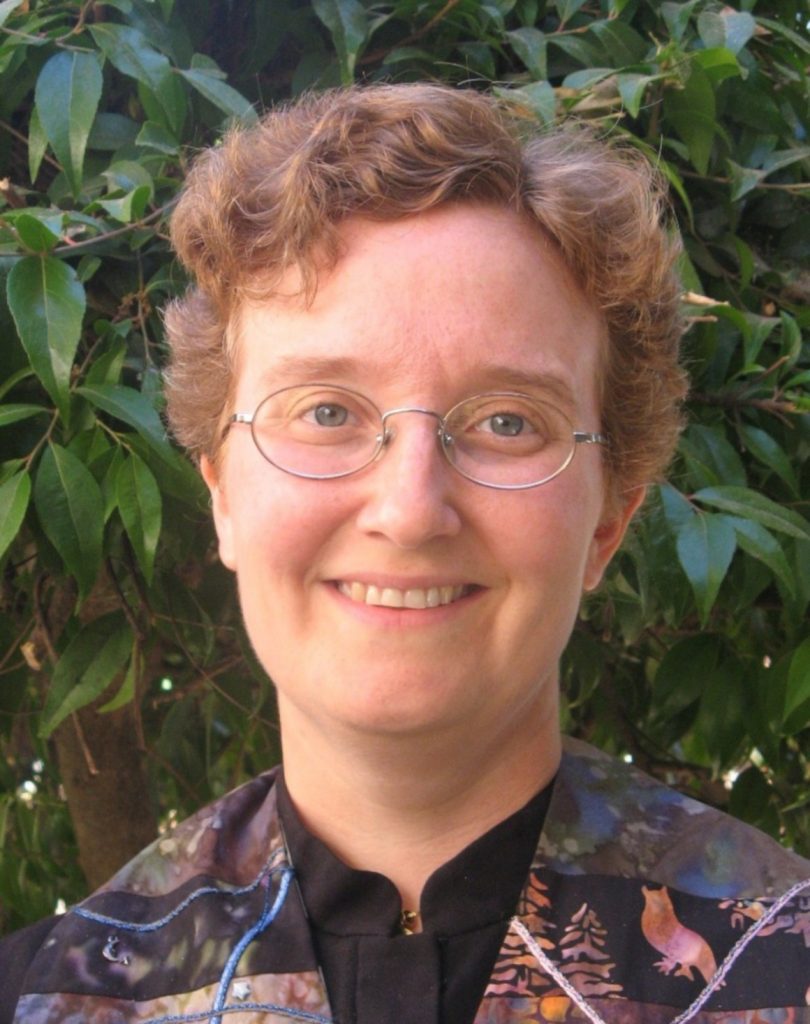

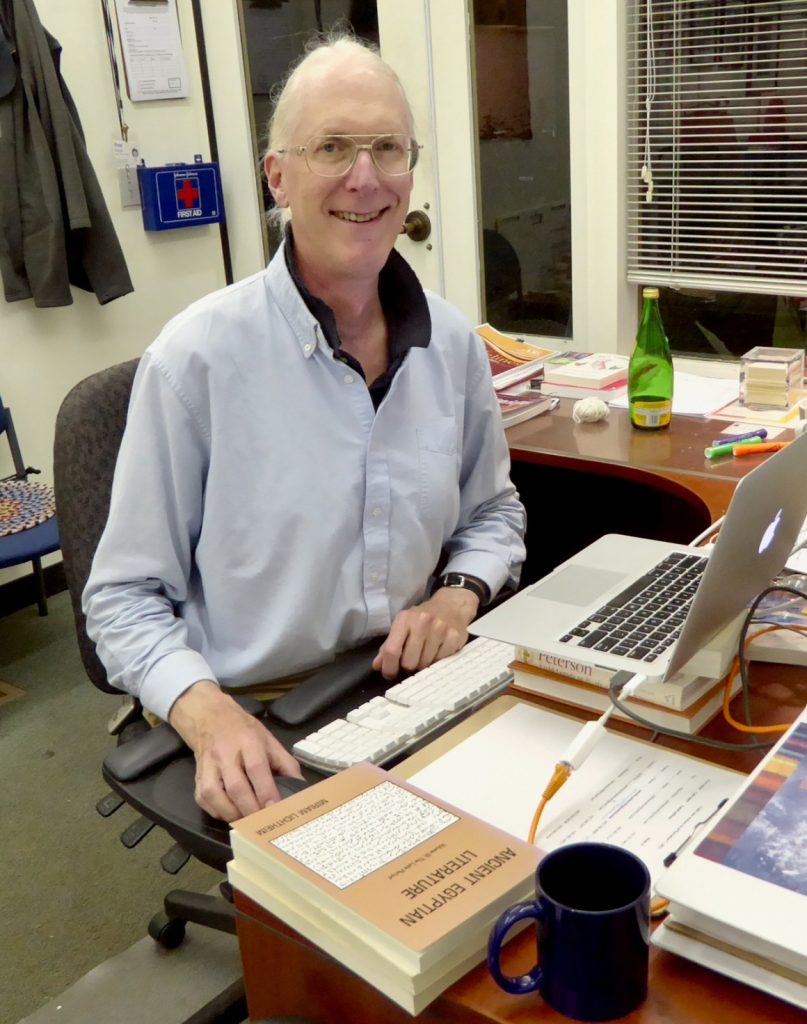
Religious Educators
1948-1949 — Religious Education Committee run program in cooperation with Palo Alto Friends Meeting
1950/51 — John Durr, Superintendent of Religious Education
1951/52 — Robert Harrison
1952/53 — Evelyn Borthwick, Supervisor of Church School
1953-1955 — Religious Education Committee is in charge of the Sunday school
1955/56 — Eve Wilder volunteers as Superintendent of Religious Education
1956/57 — Religious Education Committee is in charge of the Sunday school (no one volunteers to be Superintendent)
1957/58 — Marion Murphy, Superintendent of Religious Education (first paid religious educator, part-time)
1959/59 — C. Sargent Hearn, Director of Religious Education (DRE) (first F/T paid religious educator)
1959-1965 — Florence Sund, DRE
1965/66 — Meredith Whitaker, Acting DRE
1966-1969 — Clarice Gault, DRE
1969-1971 — Virginia Stephens and Ellen Thacher, Co-DREs
1971-1977 — Rev. Dr. Ron Hargis, Minister of Religious Education (MRE)
1977-1979 — Dr. Robert Donmoyer and June Yennie-Donmoyer, Co-DREs
1979-1983 — Mary Brau, DRE
1982/1983 — Sandy Price, (Interim) DRE
1983-1985 — Mary Katherine Haynes, DRE
1985 — Donna Bookbinder, “temporary DRE”
1985-1988 — Jean Blackburn Conner, DRE
1988-1998 — Edith Parker, DRE
1998-2000 — Rev. Dr. Til Evans, Interim MRE
2000-2007 — Rev. Darcey Laine, MRE
2007-2009 — Rev. Eva Ceskava, Interim MRE
2009-present — Rev. Dan Harper, Assistant/Associate MRE
Community Ministers
Not yet researched


